My 12 Hours as a Madman (October 1, 1953)
My 12 Hours as a Madman
by Sidney Katz
From the October 1, 1953 issue of Maclean's.
On the morning of Thursday, June 18, 1953, I swallowed a drug which, for twelve unforgettable hours, turned me into a madman. For twelve hours I inhabited a nightmare world in which I experienced the torments of hell and the ecstasies of heaven.
I will never be able to describe fully what happened to me during my excursion into madness. There are no words in the English language designed to convey the sensations I felt or the visions, illusions, hallucinations, colors, patterns and dimensions which my disordered mind revealed.
I saw the faces of familiar friends turn into fleshless skulls and the heads of menacing witches, pigs and weasels. The gaily patterned carpet at my feet was transformed into a fabulous heaving mass of living matter, part vegetable, part animal. An ordinary sketch of a woman's head and shoulders suddenly sprang to life. She moved her head from side to side, eyeing me critically, changing back and forth from woman into man. Her hair and her neckpiece became the nest of a thousand famished serpents who leaped out to devour me. The texture of my skin changed several times. After handling a painted card I could feel my body suffocating for want of air because my skin had turned to enamel. As I patted a black dog, my arm grew heavy and sprouted a thick coat of glossy black fur.
I was repeatedly held in the grip of a terrifying hallucination in which I could feel and see my body convulse and shrink until all that remained was a hard sickly stone located in the left side of my abdomen, surrounded by a greenish-yellow vapor which poured across the floor of the room.
Time lost all meaning. Hours were telescoped into minutes; seconds stretched into hours. The room I was in changed with every breath I drew. Mysterious flashes of multicolored light came and went. The dimensions of the room, elasticlike, stretched and shrank. Pictures, chairs, curtains and lamps flew endlessly about, like planets in their orbits. My senses of feeling, smelling and hearing ran amuck. It was as though someone had rooted out the nerve nets in my brain, which control the senses, then joined them together again without thought to their proper placings.
But my hours of madness were not all filled with horror and frenzy. At times I beheld visions of dazzling beauty—visions so rapturous, so unearthly, that no artists will ever paint them. I lived in a paradise where the sky was a mass of jewels set in a background of shimmering aquamarine blue; where the clouds were apricot-colored; where the air was filled with liquid golden arrows, glittering fountains of iridescent bubbles, filigree lace of pearl and silver, sheathes of rainbow light—all constantly changing in color, design, texture and dimension so that each scene was more lovely than the one that preceded it.
Two weeks have now passed since I spent half a day as a madman. (I was so frightened and bewildered by the experience that it is only now that I am able to sit down and write a complete account of what happened to me. Even now, as I relive the nightmare from this safe distance, I grow tense and my body is bathed in perspiration.)
I volunteered to become a temporary madman in the interests of medical research into the problem of mental illness. This is one phase of research where some of the guinea pigs have to be human beings. For animals can't describe their sensations.
The drug I took was LSD—lysergic acid diethylamide—an alkaloid of ergot, the poisonous rust that sometimes grows on rye. Two years ago when bread made of infected rye flour was sold in a French village many of the inhabitants died of poisoning or went stark raving mad. The mental condition produced by this drug—developed by a Swiss chemist—closely resembles acute schizophrenia, the most prevalent and the most serious form of mental disease in Canada. About half the patients in our mental hospitals suffer from some form of this terrible mental torture.
In spite of the fact that psychiatrists identified schizophrenia (sometimes known as dementia praecox or "split personality") fifty years ago, our information about it is still scanty. We do know that the victim lives in a disordered world of his own, suffering from hallucinations and delusions. His thinking, mood and behavior are affected. Schizophrenics sometimes commit suicide and murder in response to false beliefs which overpower them.
Letter from Humphry Osmond to Sidney Katz, Aug. 15, 1953
As to the cause of this disease, there are two main schools of thought. One group—particularly the psychoanalysts—tends to believe that the schizophrenic can't cope with the difficulties of life and therefore withdraws to a world of fantasy. The other group holds that schizophrenia is the direct result of a metabolic disorder—the internal glands have gone haywire, upsetting the body chemistry. They suspect that the culprit is the adrenal gland system, which in a complicated way produces a poisonous substance which causes the insanity.
These theories are not necessarily exclusive. Dr. Hans Selye, the University of Montreal scientist, has shown how stress and strain can so affect the functioning of the internal glands—including the adrenals—that they can produce a variety of illnesses, including mental illness.
By artificially creating a condition like schizophrenia in a normal person—as was done in my case—researchers hope to find the answers to a number of hitherto baffling questions. The psychiatrist wants to know: What does a schizophrenic feel? What does he see? What does he think? How does he think? How can he best be approached by a therapist? These answers are not easy to obtain from the chronic psychotic who has little or no insight and is usually uncommunicative. The biochemist seeks information which may finally lead to a cure for schizophrenia: What toxic substance is found in the psychotic which is absent in the body of the normal person? If this substance can be identified, then it is conceivable that a chemical agent can be created to counteract it, very much as penicillin and Aureomycin can kill certain kinds of infection. This could theoretically lead to the cure of half our mental patients.
Dr. Osmond spread a towel on Katz’ eyes and promised “a pleasant surprise”. Instantly he was transported to a temple at the gates of paradise, in which paraded tiny Oriental empresses in gowns studded in bright gems.
The bizarre experiment in which I was involved was apart of a research project being conducted by the Saskatchewan Schizophrenia Research group, with funds provided by the Department of National Health and Welfare, Ottawa. The research team headed by psychiatrist and biochemist Abe Hoffer, includes Drs. Humphry Osmond, Ronald Fisher, John Smythies, and psychologists Ben Stefaniuk and Neil Agnew. So far nineteen volunteers have taken the drug. Eighteen of them are members of the nursing and medical staffs of mental hospitals. So far as I am aware, I am the only outsider to have taken the drug. The results of the experiments are now being carefully studied and analyzed. No experimental drugs can ever be given to mental patients. For to further weaken their slender hold on reality would probably rule out all possibility of a cure at some future time.
I stepped into the Stygian world of schizophrenia from the officers' lounge in the Saskatchewan Hospital in Weyburn. It is a comfortable, homey living room, twenty-eight by twenty fee, furnished with a soft rug, chesterfield, easy chairs, end tables, lamps and oil paintings. Preparations for the experiment had begun early in the morning of Thursday, June 18. Psychologist Ben Stefaniuk gave me a Rorschach test to measure my emotional stability. In this test, you view a series of ink blots and describe what you see in them. I passed with flying colors. This precaution is always taken; the LSD drug might have lasting effects on an emotionally unstable person.
Several preparations were made to help me recall later what I had experienced. A tape recorder stood on the table in front of me. It was to operate for four hours—the period of my most severe derangement. On either side of me were Stefaniuk and Dr. Humphry Osmond, clinical director of the Weyburn hospital. They were to interview me constantly, eliciting what I was feeling, seeing and thinking. Also present were Charles Jillings, a staff psychologist of the hospital, and Elaine Cumming, a sociologist, who carefully recorded the movement of people in and out of the room and my reactions to them. Mike Kesterton, a photographer, constantly shot pictures in color and black-and-white film both for Maclean's and for the project's records. This was the first LSD experiment n Saskatchewan to be recorded photographically. Throughout my psychosis various doctors were quietly ushered into the room to make observations and ask me questions.
Osmond and Stefaniuk were to be my main links with the world of reality. During the brief flashes of lucidity, they were to try and help me ward off the devastating feelings of despair and fear which were to overtake me. They constantly reminded me—not always successfully—that I was Sidney Katz, a Maclean's editor; that I was in a hospital in Weyburn; that I had taken a drug which produced a condition like schizophrenia; that the effects would wear off before the day was over.
Past experience has shown that LSD produces such an overwhelming emotional and intellectual upheaval in the individual, that the experiment must be very rigidly controlled. At no time was I left alone. Once, in a Swiss mental hospital, a practical joker sneaked a few grains of LSD into a staff nurse's coffee. The frantic girl, apparently driven to believe that she had become schizophrenic, leaped to her death from the hospital rooftop.
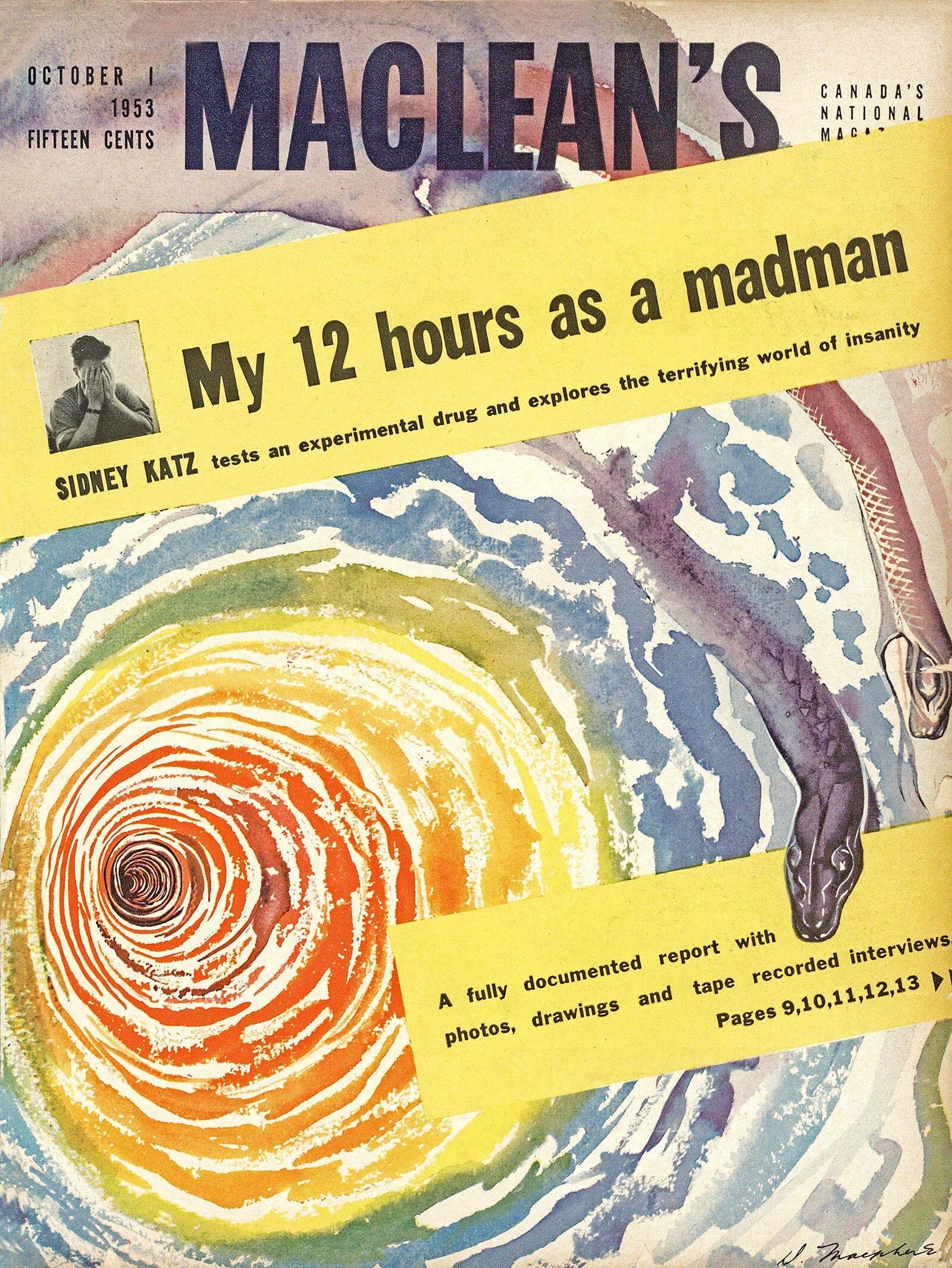

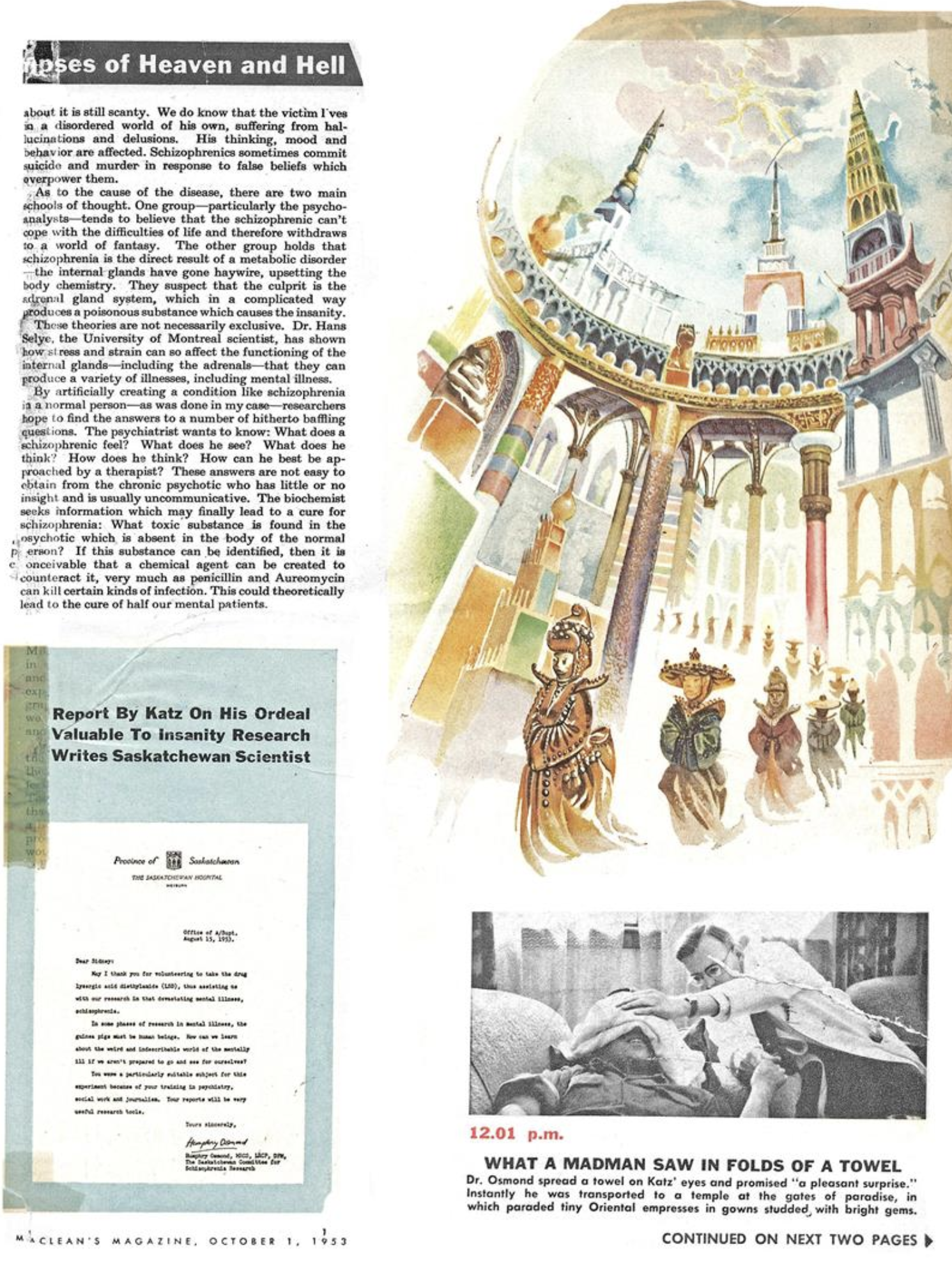

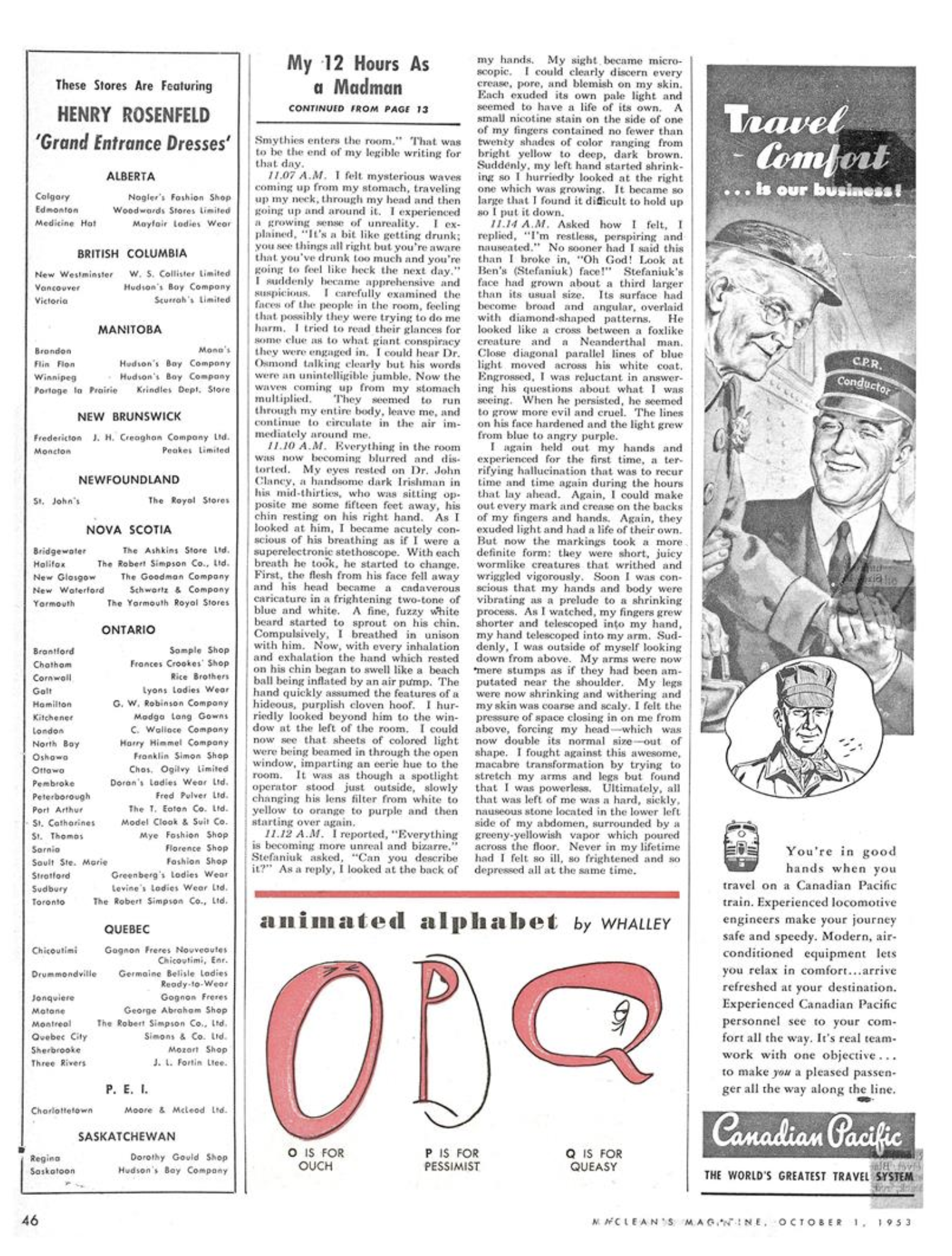
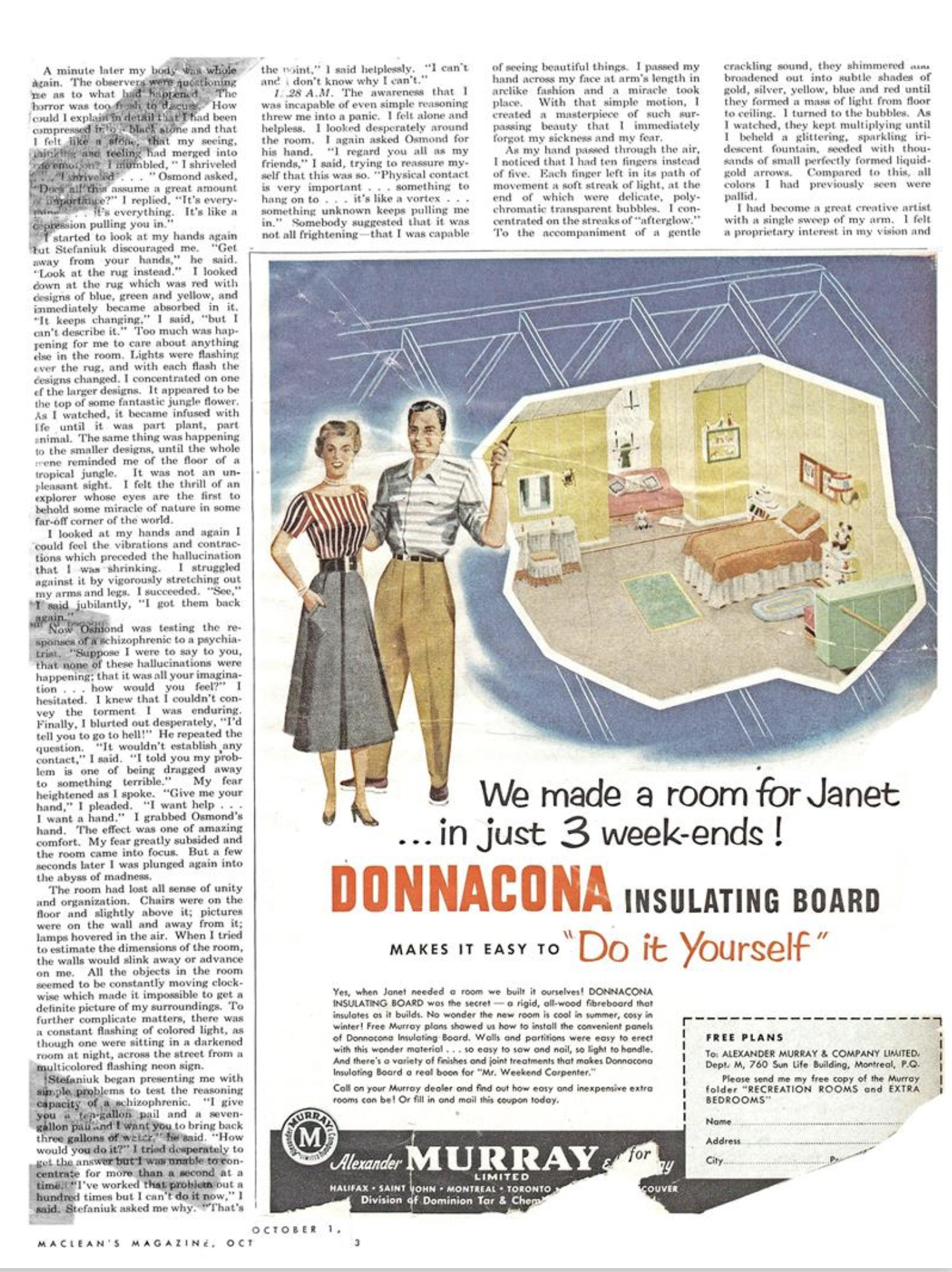
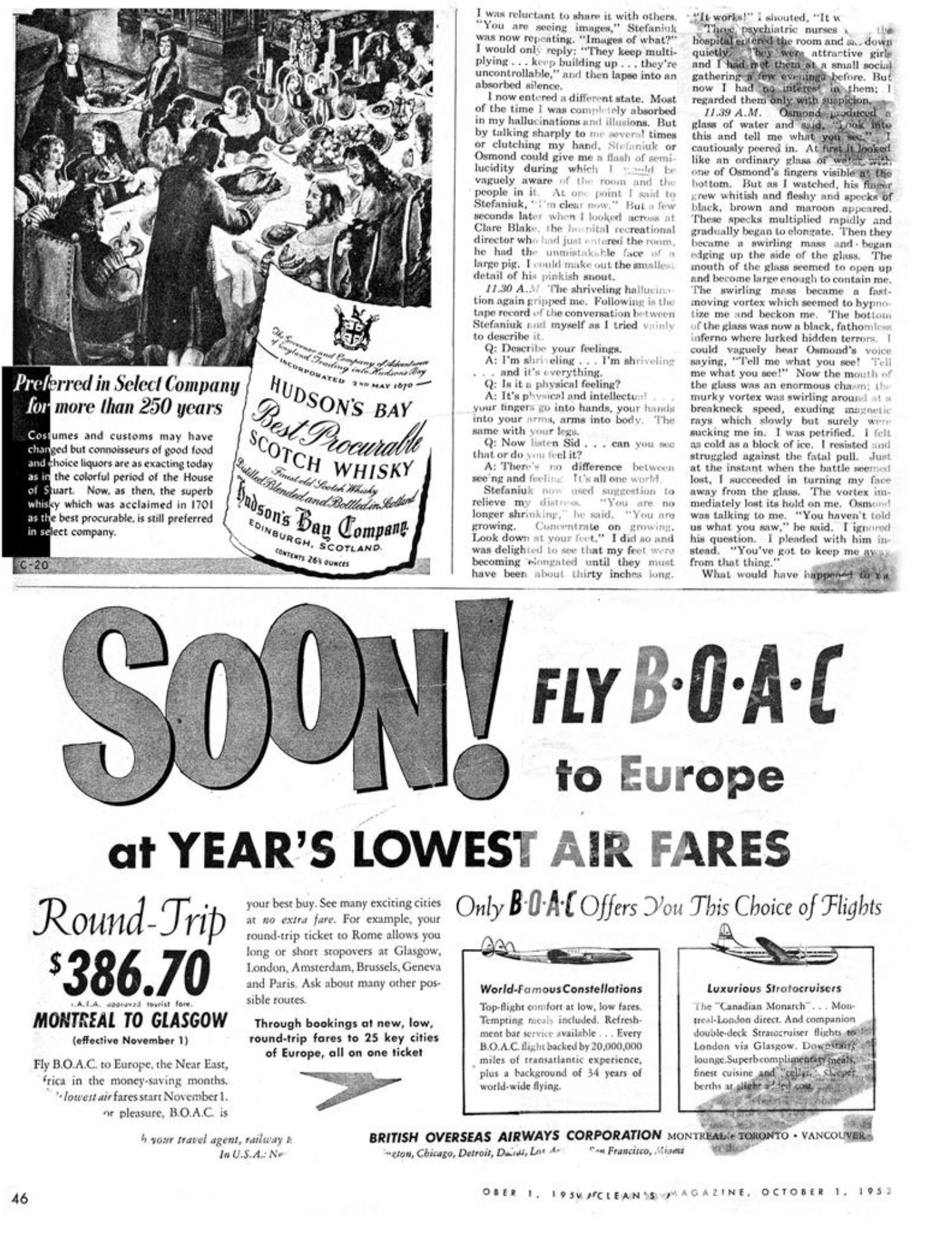
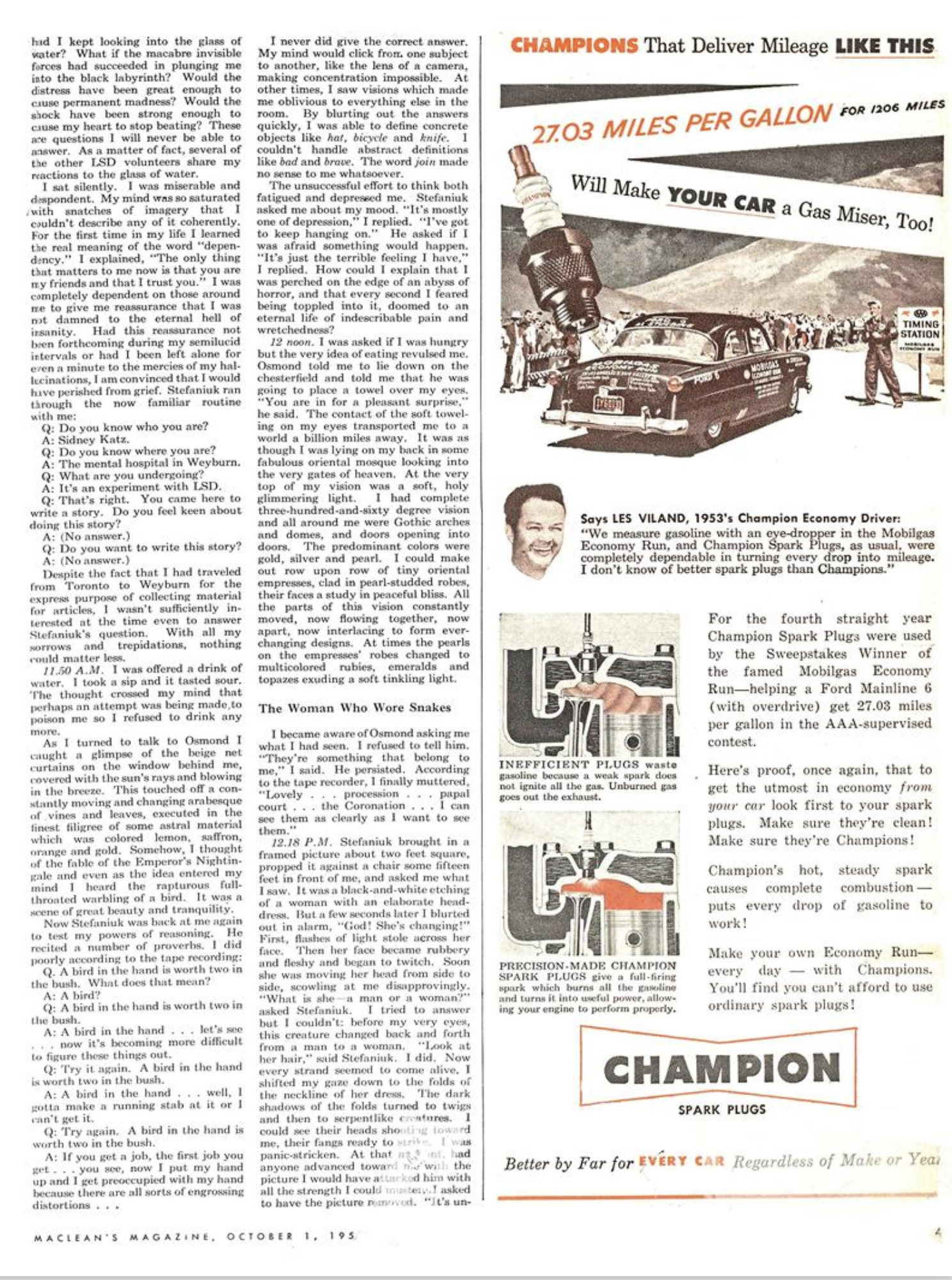
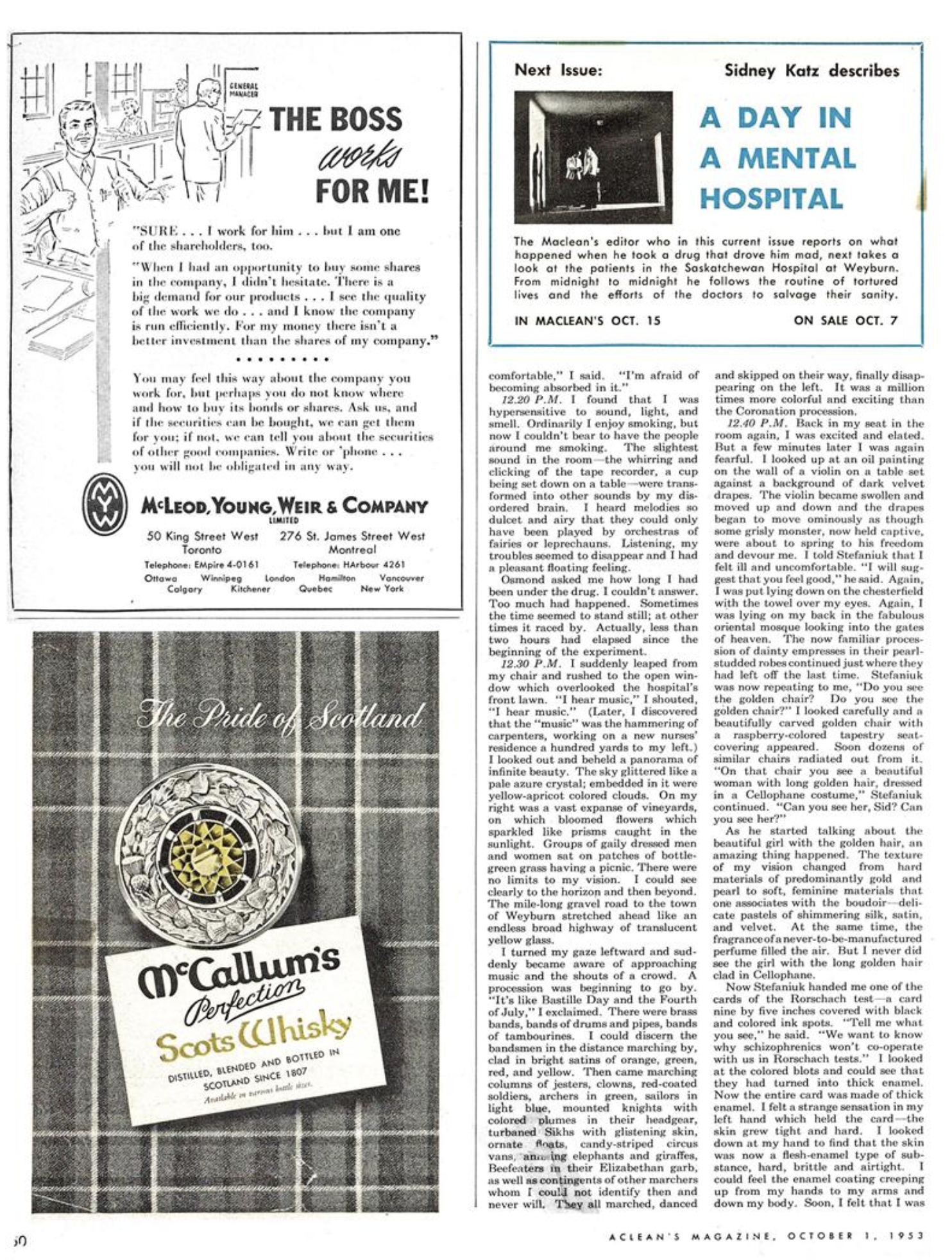
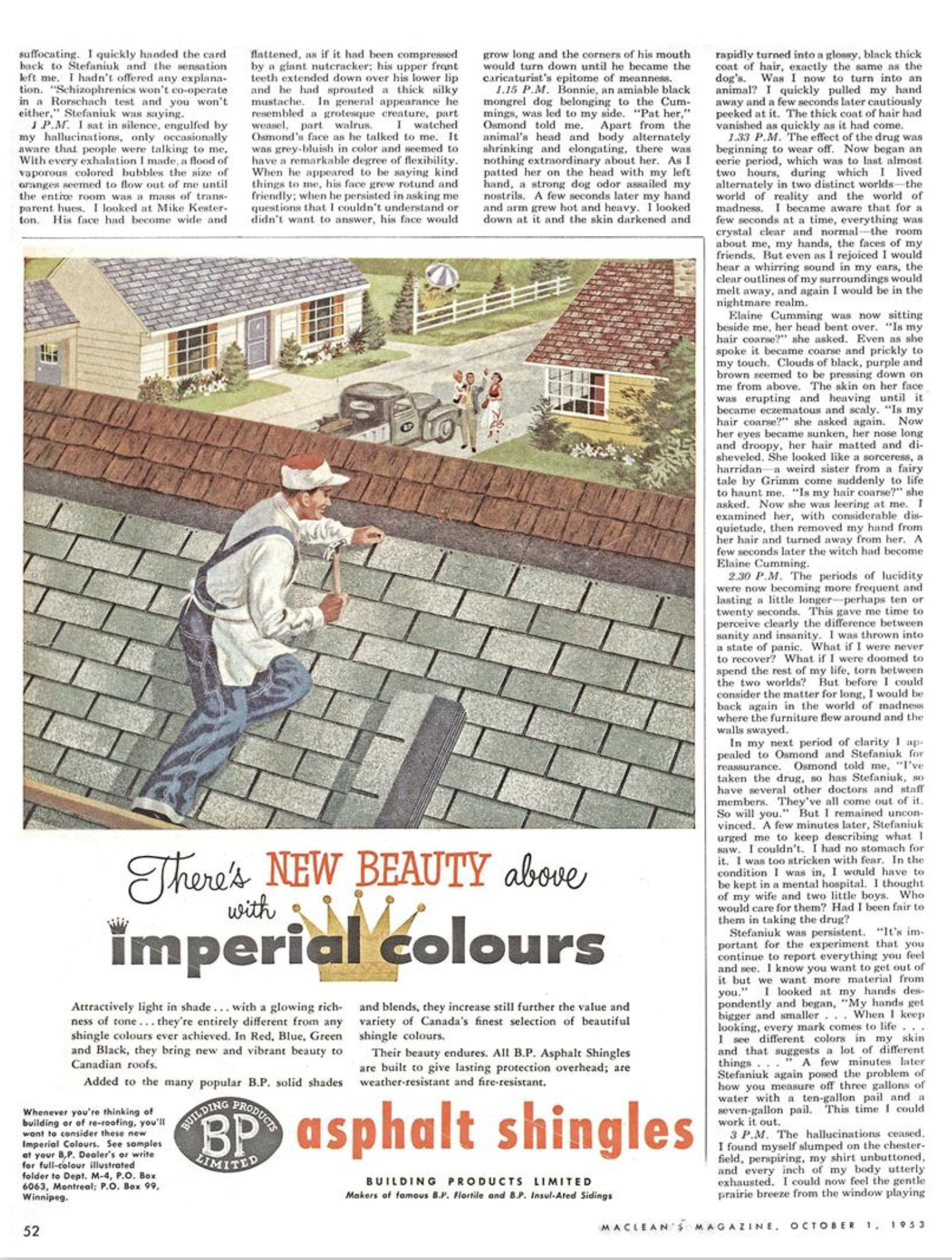
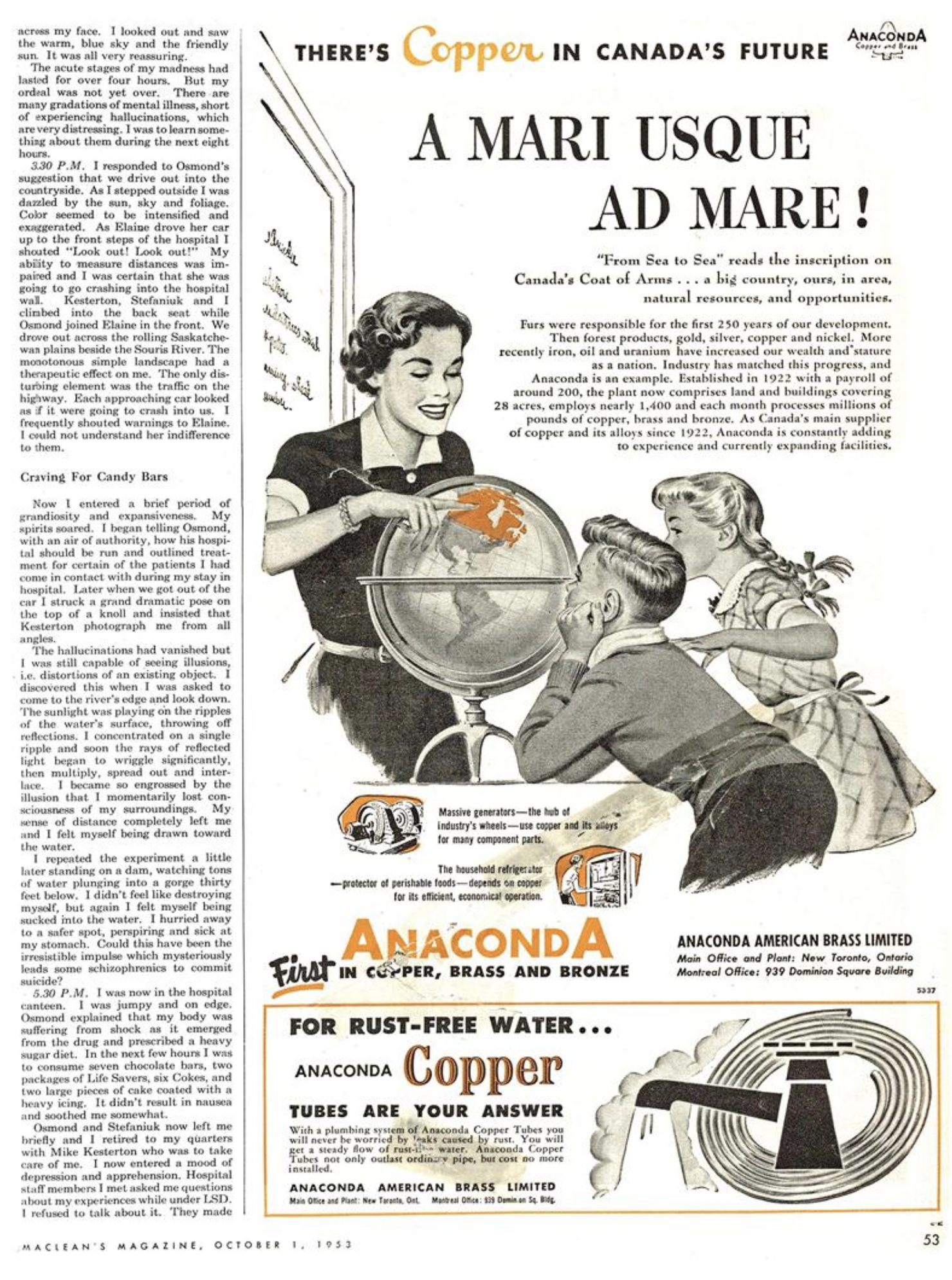
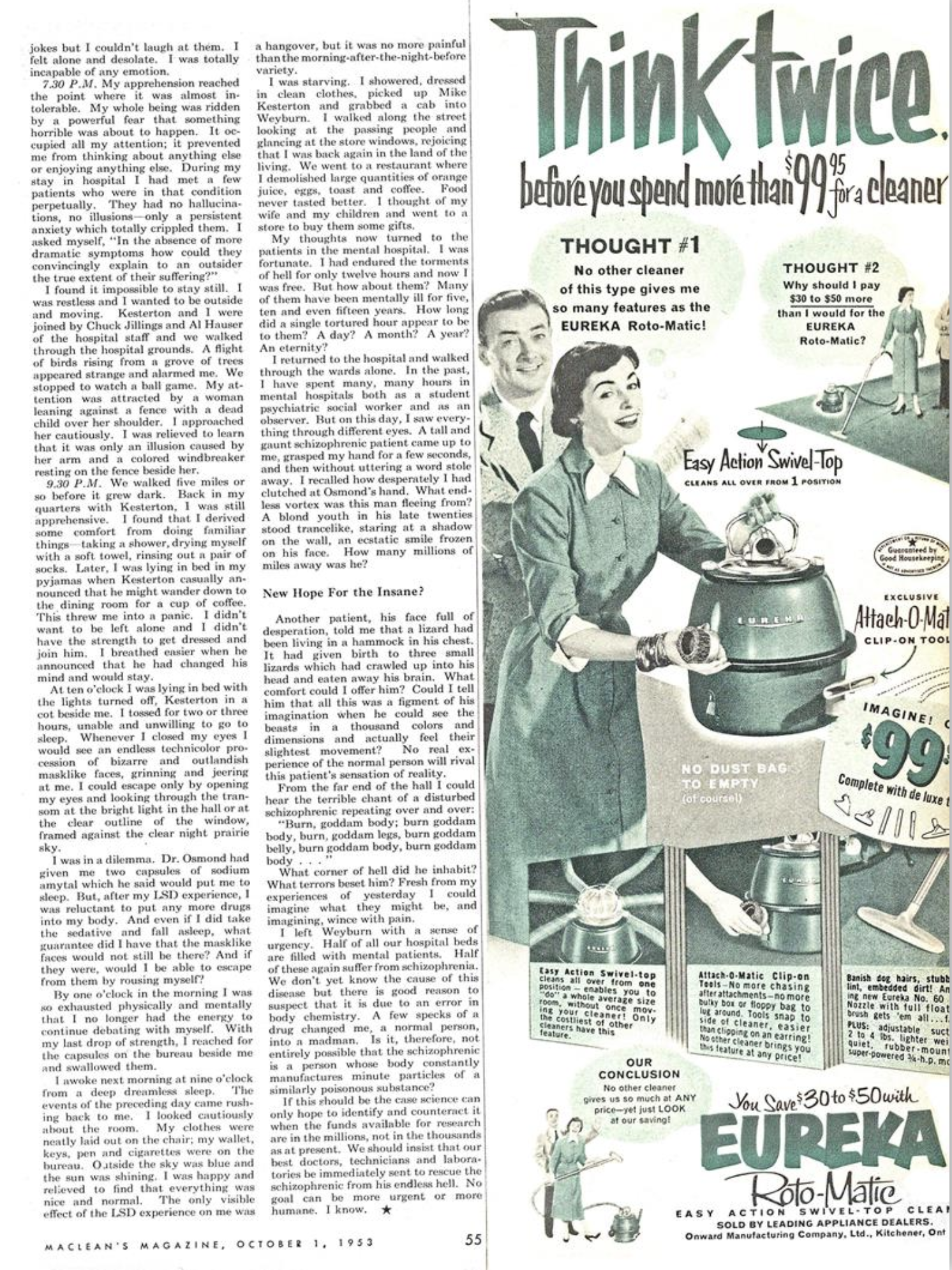
What follows below is a detailed description of what happened to me after I took the drug. I pieced this account together from my own vivid but distorted recollections, aided by tape recording. Mike Kesterton's photographs, sociologist Cumming's notebooks and from later interviews with other observers who were present.
10.45 A.M. I was handed half a glass of water containing two hundred one-millionths (200/1,000,000) of a gram of LSD by Dr. Osmond. This amount of the drug could comfortably sit on the head of a pin. I drank it. The liquid had no taste or smell.
There were immediate effects. The talk in the room centred about Kesterton and his cameras and equipment. Beside me on the arm of my chair was my black leather notebook in which I had hoped to record much of the experiment. At 11.02, I wrote: "My co-ordination is not so good." At 11.03: "Slight nausea." At 11.06, in a sprawling hand, "John Smythies enters the room." That was to be the end of my legible writing for that day.
11.07 A.M. I felt mysterious waves coming from my stomach, traveling up my neck, through my head and then going up and around it. I experienced a growing sense of unreality. I explained, "It's a bit like getting drunk; you see things all right but you're aware that you've drunk too much and you're going to feel like heck the next day." I suddenly became apprehensive and suspicious. I carefully examined the faces of the people in the room, feeling that possibly they were trying to do me harm. I tried to read their glances for some clue as to what giant conspiracy they were engaged in. I could hear Dr. Osmond talking clearly but his words were an unintelligible jumble. Now the waves coming up from my stomach multiplied. They seemed to run through my entire body, leave me, and continue to circulate in the air immediately around me.
11.10 A.M. Everything in the room was now becoming blurred and distorted. My eyes rested on Dr. John Clancy, a handsome dark Irishman in his mid-thirties, who was sitting opposite me some fifteen feet away, his chin resting on his right hand. As I looked at him, I became acutely suspicious of his breathing as if I were a superelectronic stethoscope. With each breath he took, he started to change. First, the flesh from his face fell away and his head became a cadaverous caricature in a frightening two-tone of blue and white. A fine, fuzzy white beard started to sprout on his chin. Compulsively, I breathed in unison with him. Now, with every inhalation and exhalation the hand which rested on his chin began to swell like a beach ball being inflated by an air pump. The hand quickly assumed the features of a hideous, purplish cloven hoof. I hurriedly looked beyond him to the window at the left of the room. I could now see that sheets of colored light were being beamed in through the open window, imparting an eerie hue to the room. It was as through a spotlight operator stood just outside, slowly changing his lens filter from white to yellow to orange to purple and then starting over again.
11.12 A.M. I reported, "Everything is becoming more unreal and bizarre." Stefaniuk asked, "Can you describe it?" As a reply, I looked at the back of my hands. My sight became microscopic. I could clearly discern every crease, pore, and blemish on my skin. Each exuded its own pale light and seemed to have a life of its own. A small nicotine stain on the side of one of my fingers contained no fewer than twenty shades of color ranging from bright yellow to deep, dark brown. Suddenly, my left hand started shrinking so I hurriedly looked at the right one which was growing. It become so large that I found it difficult to hold up so I put it down.
11.14 A.M. Asked how I felt, I replied, "I'm restless, perspiring and nauseated." No sooner had I said this than I broke in, "Oh, God! Look at Ben's (Stefaniuk) face!" Stefaniuk's face had grown about a third larger than its usual size. Its surface had become broad and angular, overlaid with diamond-shaped patterns. He looked like a cross between a foxlike creature and a Neanderthal man. Close diagonal parallel lines of blue light moved across his white coat. Engrossed, I was reluctant in answering his questions about what I was seeing. When he persisted, he seemed to grow more evil and cruel. The lines on his face hardened and the light grew from blue to angry purple.
I again held out my hands and experienced for the first time a terrifying hallucination that was to recur time and time again during the hours that lay ahead. Again, I could make out every mark and crease on the backs of my fingers and hands. Again, they exuded light and had a life of their own. But now the markings took a more definite form: they were short, juicy wormlike creatures that writhed and wriggled vigorously. Soon I was conscious that my hands and body were vibrating as a prelude to a shrinking process. As I watched, my fingers grew shorter and telescoped into my hand, my hand telescoped into my arm. Suddenly, I was outside of myself looking down from above. My arms were now mere stumps as if they had been amputated near the shoulder. My legs were now shrinking and withering and my skin was coarse and scaly. I felt the pressure of space closing in on me from above, forcing my head—which was now double its original size—out of shape. I fought against this awesome macabre transformation by trying to stretch my arms and legs but found that I was powerless. Ultimately, all that was left of me was a hard, sickly nauseous stone located in the lower left side of my abdomen, surrounded by a greeny-yellowish vapor which poured across the floor. Never in my lifetime had I felt so ill, so frightened and so depressed all at the same time.
A minute later my body was whole again. The observers were questioning me as to what had happened. The horror was too fresh to discuss. How could I explain in detail that I had been compressed into a black stone and that I felt like a stone; that my seeing, thinking and feeling had merged into one emotion? I mumbled, "I shriveled … I shriveled … " Osmond asked, "Does all this assume a great amount of importance?" I replied, "It's everything … it's everything. It's like a depression pulling you in.”
I started to look at my hands again but Stefaniuk discouraged me. "Get away from your hands," he said. "Look at the rug instead." I looked down at the rug which was red with designs of blue, green and yellow, and immediately became absorbed in it. "It keeps changing," I said, "but I can't describe it." Too much was happening for me to care about anything else in the room. Lights were flashing over the rug, and with each flash the designs changed. I concentrated on one of the larger designs. It appeared to be the top of some fantastic jungle glower. As I watched, it became infused with life until it was part plant, part animal. The same thing was happening in the smaller designs, until the whole scene reminded me of the floor of a tropical jungle. It was not an unpleasant sight. I felt the thrill of an explorer whose eyes are the first to behold some miracle of nature in some far-off corner of the world.
I looked at my hands and again I could feel the vibrations and contractions which preceded the hallucination that I was shrinking. I struggled against it by vigorously stretching out my arms and legs. I succeeded. "See," I said jubilantly, "I got them back again."
Now Osmond was testing the responses of a schizophrenic to a psychiatrist. "Suppose I were to say to you, that none of these hallucinations were happening; that it was all your imagination … how would you feel?" I hesitated. I knew that I couldn't convey the torment I was enduring. Finally, I blurted out desperately, "I'd tell you to go to hell!" He repeated the question. "It wouldn't establish any contact," I said. "I told you my problem is one of being dragged away to something terrible." My fear heightened as I spoke. "Give me your hand," I pleaded. "I want help … I want a hand." I grabbed Osmond's hand. The effect was one of amazing comfort. My fear greatly subsided and the room came into focus. But a few seconds later I was plunged again into an abyss of madness.
The room had lost all sense of unity and organization. Chairs were on the floor and slightly above it; pictures were on the wall and away from it; lamps hovered in the air. When I tried to estimate the dimensions of the room, the walls would slink away or advance on me. All the objects in the room seemed to be constantly moving clockwise which made it impossible to get a definite picture of my surroundings. To further complicate matters, there was a constant flashing of colored light, as though one were sitting in a darkened room at night, across the street from a multicolored flashing neon sign.
Stefaniuk began presenting me with simple problems to test the reasoning capacity of a schizophrenic. "I give you a ten-gallon pail and I want you to bring back three gallons of water," he said. "How would you do it?" I tried desperately to get the answer but I was unable to concentrate for more than a second at a time. "I've worked that problem out a hundred times but I can't do it now," I said. Stefaniuk asked me why. "That's the point," I said helplessly. "I can't, and I don't know why I can't."
11.28 A.M. The awareness that I was incapable of even simple reasoning threw me into a panic. I felt alone and helpless. I looked desperately around the room. I again asked Osmond for his hand. "I regard you all as my friends," I said, trying to reassure myself that this was so. "Physical contact is very important … something to hang on to … it's like a vortex … something unknown keeps pulling me in." Somebody suggested that it was not all frightening—that I was capable of seeing beautiful things. I passed my hand across my face at arm's length in arclike fashion and a miracle took place. With that simple motion, I created a masterpiece of such surpassing beauty that I immediately forgot my sickness and fear.
As my hand passed through the air, I noticed that I had ten fingers instead of five. Each finger left in its path of movement a soft streak of light, at the end of which were delicate, polychromatic transparent bubbles. I concentrated on the streaks of "afterglow." To the accompaniment of a gentle crackling sound, they shimmered and broadened out into subtle shades of gold, silver, yellow, blue and red until they formed a mass of light from floor to ceiling. I turned to the bubbles. As I watched, they kept multiplying until I beheld a glittering, sparkling iridescent fountain, seeded with thousands of small perfectly formed liquid-gold arrows. Compared to this, all colors I had previously seen were pallid.
I had become a great creative artist with a single sweep of my arm. I felt a proprietary interest in my vision and I was reluctant to share it with others. "You are seeing images," Stefaniuk was now repeating. "Images of what?" I would only reply: "They keep multiplying … keep building up … they're uncontrollable," and then lapse into an absorbed silence.
I now entered a different state. Most of the time I was completely absorbed in my hallucinations and illusions. But by talking sharply to me several times or clutching my hand, Stefaniuk or Osmond could give me a flash of semi-lucidity during which I would be vaguely aware of the room and the people in it. At one point I said to Stefaniuk, "I'm clear now." But a few seconds later when I looked across at Clare Blake, the hospital recreational director who had just entered the room, he had the unmistakable face of a large pig. I could make out the smallest detail of his pinkish snout.
11.30 A.M. The shriveling hallucination again gripped me. Following is the tape record of the conversation between Stefaniuk and myself as I tried vainly to describe it.
Q: Describe your feelings.
A: I'm shriveling … I'm shriveling … and it's everything.
Q: Is it a physical feeling?
A: It's physical and intellectual … your fingers go into hands, your hands into your arms, arms into body. The same with your legs.
Q: Now listen Sid … can you see that or do you feel it?
A: There's no difference between seeing and feeling. It's all one world.
Stefaniuk now used suggestions to relieve my distress. "You are no longer shrinking," he said. "You are growing. Concentrate on growing. Look down at your feet." I did so and was delighted to see that my feet were becoming elongated until they must have been about thirty inches long. "It works!" I shouted. "It works!"
Three psychiatric nurses from the hospital; entered the room and sat down. They were attractive girls and I had met them at a small social gathering a few evenings before. But now I had no interest in them; I regarded them only with suspicion.
11.39 A.M. Osmond produced a glass of water and said, "Look into this and tell me what you see." I cautiously peered in. At first it looked like an ordinary glass of water with one of Osmond's fingers visible at the bottom. But as I watched, his finger grew whitish and fleshy and specks of black, brown and maroon appeared. These specks multiplied rapidly and gradually began to elongate. Then they became a swirling mass and began edging up the side of the glass. The mouth of the glass seemed to open up and become large enough to contain me. The swirling mass became a fast-moving vortex which seemed to hypnotize me and beckon me. The bottom of the glass was now a black, fathomless inferno where lurked hidden terrors. I could vaguely hear Osmond's voice saying, "Tell me what you see! Tell me what you see!" Now the mouth of the glass was an enormous chasm; the murky vortex was swirling around at a breakneck speed, exuding magnetic rays which slowly but surely were sucking me in. I was petrified. I felt as cold as a block of ice. I resisted and struggled against the fatal pull. Just at the instant when the battle seemed lost, I succeeded in turning my face away from the glass. The vortex immediately lost its hold on me. "You haven't told us what you saw," he said. I ignored his question. I pleaded with him instead. "You've got to keep me away from that thing."
What would have happened to me had I kept looking into the glass of water? What if the macabre invisible forces had succeeded in plunging me into the black labyrinth? Would the distress have been great enough to cause permanent madness? Would the shock have been strong enough to cause my heart to stop beating? These are questions I will never be able to answer. As a matter of fact, several of the other LSD volunteers share my reactions to the glass of water.
I sat silently. I was miserable and despondent. My mind was so saturated with snatches of imagery that I couldn't describe any of it coherently. For the first time in my life I learned the real meaning of the word "dependency." I explained, "The only thing that matters to me now is that you are my friends and that I trust you." I was completely dependent on those around me to give me reassurance that I was not damned to the eternal hell of insanity. Had this reassurance not been forthcoming during my semilucid intervals or had I been left alone for even a minute to the mercies of my hallucinations, I am convinced that I would have perished from grief. Stefaniuk ran through the now familiar routine with me:
Q: Do you know who you are?
A: Sidney Katz.
Q: Do you know where you are?
A: The mental hospital in Weyburn.
Q: What are you undergoing?
A: It's an experiment with LSD.
Q: That's right. You came here to write a story. Do you feel keen about doing this story?
A: (No answer.)
Q: Do you want to write this story?
A: (No answer.)
Despite the fact that I had traveled from Toronto to Weyburn for the express purpose of collecting material for articles, I wasn't sufficiently interested at the time even to answer Stefaniuk's question. With all my sorrows and trepidations, nothing could matter less.
11.50 A.M. I was offered a drink of water. I took a sip and it tasted sour. The thought crossed my mind that perhaps an attempt was being made to poison me so I refused to drink anymore.
As I turned to talk to Osmond I caught a glimpse of the beige net curtains on the window behind me, covered with the sun's rays and blowing in the breeze. This touched off a constantly moving and changing arabesque of vines and leaves, executed in the finest filigree of some astral material which was colored lemon, saffron, orange and gold. Somehow, I thought of the fable of the Emperor's Nightingale and even as the idea entered my mind I heard the rapturous, full-throated warbling of a bird. It was a scene of great beauty and tranquility.
Now Stefaniuk was back at me again to test my powers of reasoning. He recited a number of proverbs. I did poorly according to the tape recording:
Q: A bird in the hand is worth two in the bush. What does that mean?
A: A bird?
Q: A bird in the hand is worth two in the bush.
A: A bird in the hand… let's see… now it's becoming more difficult to figure these things out.
Q: Try it again. A bird in the hand is worth two in the bush.
A: A bird in the hand… well, I gotta make a running stab at it or I can't get it.
Q: Try again. A bird in the hand is worth two in the bush.
A: If you get a job, the first job you get… you see, now I put my hand up and I get preoccupied with my hand because there are all sorts of engrossing distortions…
I never did get the correct answer. My mind would click from one subject to another, like the lens of a camera, making concentration impossible. At other times, I saw visions which made me oblivious to everything else in the room. By blurting out the answers quickly, I was able to define concrete objects like hat, bicycle and knife. I couldn't handle abstract definitions like bad and brave. The word join made no sense to me whatsoever.
The unsuccessful effort to think both fatigued and depressed me. Stefaniuk asked me about my mood. "It's mostly one of depression," I replied. "I've got to keep hanging on." He asked if I was afraid something terrible would happen. "It's just the terrible feeling I have," I replied. How could I explain that I was perched on the edge of an abyss of horror, and that every second I feared being toppled into it, doomed to an eternal life of indescribable pain and wretchedness?
12 noon I was asked if I was hungry but the very idea of eating revulsed me. Osmond told me to lie down on the chesterfield and told me that he was going to place a towel over my eyes. "You are in for a pleasant surprise," he said. The contact of the soft toweling on my eyes transported me to a world a billion miles away. It was as though I was lying on my back in some fabulous oriental mosque looking into the very gates of heaven. At the very top of my vision was a soft, holy glimmering light. I had complete three-hundred-and-sixty degree vision and all around me were Gothic arches and domes, and doors opening into doors. The predominant colors were gold, silver and pearl. I could make out row upon row of tiny oriental empresses, clad in pearl-studded robes, their faces a study of peaceful bliss. All the parts of this vision constantly moved, now flowing together, now apart, now interlacing to form ever-changing designs. At times the pearls on the empresses' robes changed to multicolored rubies, emeralds and topazes exuding a soft tinkling light.
The Woman Who Wore Snakes
I became aware of Osmond asking me what I had seen. I refused to tell him. "They're something that belong to me," I said. He persisted. According to the tape recorder, I finally muttered, "Lovely… procession… papal court… the Coronation… I can see them as clearly as I want to see them."
12.18 P.M. Stefaniuk brought in a framed picture about two feet square, propped it against a chair some fifteen feet in front of me, and asked me what I saw. It was a black-and-white etching of a woman with an elaborate headdress. But a few seconds later I blurted out in alarm, "God! She's changing!"
First, flashes of light stole across her face. Then her face became rubbery and fleshy and began to twitch. Soon she was moving her head from side to side, scowling at me disapprovingly. What is she, a man or a woman?" asked Stefaniuk. I tried to answer but I couldn't: before my very eyes, this creature changed back and forth from a man to a woman. "Look at her hair," said Stefaniuk. I did. Now every strand seemed to come alive. I shifted my gaze down to the folds of the neckline of her dress. The dark shadows of the folds turned to twigs and then to serpentlike creatures. I could see their heads shooting toward me, their fangs ready to strike. I was panic-stricken. At that moment, had anyone advanced toward me with the picture I would have attacked him with all the strength I could muster. I asked to have the picture removed. "It's uncomfortable," I said. "I'm afraid I'm becoming absorbed in it."
12.20 P.M. I found that I was hypersensitive to sound, light, and smell. Ordinarily I enjoy smoking, but now I couldn't bear to have the people around me smoking. The slightest sound in the room—the whirring and clicking of the tape recorder, a cup being set down on a table—were transformed into other sounds by my disordered brain. I heard melodies so dulcet and airy that they could only have been played by orchestras of fairies or leprechauns. Listening, my troubles seemed to disappear and I had a pleasant floating feeling.
Osmond asked me how long I had been under the drug. I couldn't answer. Too much had happened. Sometimes the time seemed to stand still; at other times it raced by. Actually, less than two hours had elapsed since the beginning of the experiment.
12:30 P.M. I suddenly leaped from my chair and rushed to the open window which overlooked the hospital's front lawn. "I hear music," I shouted. "I hear music." (Later, I discovered that the "music" was the hammering of carpenters, working on a new nurses' residence a hundred yards to my left.) I looked out and beheld a panorama of infinite beauty. The sky glittered like a pale azure crystal; embedded in it were yellow-apricot colored clouds. On my right was a vast expanse of vineyards, on which bloomed flowers which sparkled like prisms caught in the sunlight. Groups of gaily dressed men and women sat on patches of bottle-green grass having a picnic. There were no limits to my vision. I could see clearly to the horizon and then beyond. The mile-long gravel road to the town of Weyburn stretched ahead like an endless broad highway of translucent yellow glass.
I turned my gaze leftward and suddenly became aware of the approaching music and the shouts of a crowd. A procession as beginning to go by. "It's like Bastille Day and the Fourth of July," I exclaimed. There were brass bands, bands of drums and pipes, bands of tambourines. I could discern the bandsmen in the distance marching by, clad in bright satins of orange, green, red and yellow. Then came marching columns of jesters, clowns, red-coated soldiers, archers in green, sailors in light blue, mounted knights with colored plumes in their headgear, turbaned Sikhs with glistening skin, ornate floats, candy-striped circus vans, ambling elephants and giraffes. Beefeaters in their Elizabethan garb, as well as contingents of other marchers whom I could not identify then and never will. They all marched, danced and skipped on their way, finally disappearing on the left. It was a million times more colorful and exciting than the Coronation procession.
12.40 P.M. Back in my seat in the room again, I was excited and elated. But a few minutes later I was again fearful. I looked up at an oil painting on the wall of a violin on a table set against a background of dark violet drapes. The violin became swollen and moved up and down and the drapes began to move ominously as though some grisly monster, now held captive, were about to spring to his freedom and devour me. I told Stefaniuk that I felt ill and uncomfortable. "I will suggest that you feel good," he said. Again, I was put lying down on the chesterfield with the towel over my eyes. Again, I was lying on my back in the fabulous oriental mosque looking into the gates of heaven. The now familiar procession of dainty empresses in their pearl-studded robes continued just where they had left off the last time. Stefaniuk was now repeating to me, "Do you see the golden chair? Do you see the golden chair?" I looked carefully and a beautifully carved golden chair with a raspberry-colored tapestry seat covering appeared. Soon dozens of similar chairs radiated out from it. "On that chair you see a beautiful woman with long golden hair, dressed in a Cellophane costume," Stefaniuk continued. "Can you see her, Sid? Can you see her?"
As he started talking about the beautiful girl with the golden hair, an amazing thing happened. The texture of my vision changed from hard materials of predominantly gold and pearl to soft, feminine materials that one associates with the boudoir delicate pastels of shimmering silk, satin and velvet. At the same time, the fragrance of a never-to-be-manufactured perfume filled the air. But I never did see the girl with the long golden hair clad in Cellophane.
Now Stefaniuk handed me one of the cards of the Rorschach test—a card nine by five inches covered with black and colored ink spots. "Tell me what you see," he said. "We want to know why schizophrenics won't co-operate with us in Rorschach tests." I looked at the colored blots and could see that they had turned into thick enamel. Now the entire card was made of thick enamel. I felt a strange sensation in my left hand which held the card—the skin grew tight and hard. I looked down at my hand to find that the skin was now a flesh-enamel type of substance, hard, brittle and airtight. I could feel the enamel coating creeping up from my hands to my arms and down my body. Soon, I felt that I was suffocating. I quickly handed the card back to Stefaniuk and the sensation left me. I hadn't offered any explanation. "Schizophrenics won't co-operate in a Rorschach test and you won't either," Stefaniuk was saying.
1 P.M. I sat in silence, engulfed by my hallucinations, only occasionally aware that people were talking to me. With every exhalation I made, a flood of vaporous colored bubbles the size of oranges seemed to flow out of me until the entire room was a mass of transparent hues. I looked at Mike Kesterton. His face had become wide and flattened, as if it had been compressed by a giant nutcracker; his upper front teeth extended down over his lower lip and he had sprouted a thick silky mustache. In general appearance he resembled a grotesque creature, part weasel, part walrus. I watched Osmond's face as he talked to me. It was grey-bluish in color and seemed to have a remarkable degree of flexibility. When he appeared to be saying kind things to me, his face grew rotund and friendly; when he persisted in asking me questions that I couldn't understand or didn't want to answer, his face would grow long and the corners of his mouth would turn down until he became the caricaturist's epitome of meanness.
1.15 P.M. Bonnie, an amiable black mongrel dog belonging to the Cummings, was led to my side. "Pat her," Osmond told me. Apart from the animal's head and body alternately shrinking and elongating, there was nothing extraordinary about her. As I patted her on the head with my left hand, a strong dog odor assailed my nostrils. A few seconds later my hand and arm grew hot and heavy. I looked down at it and the skin darkened and rapidly turned into a glossy, black thick coat of hair, exactly the same as the dog's. Was I now to turn into an animal? I quickly pulled my hand away and a few seconds later cautiously peeked at it. The thick coat of hair had vanished as quickly as it had come.
1.33 P.M. The effect of the drug was beginning to wear off. Now began an eerie period, which was to last almost two hours, during which I lived alternately in two distinct worlds—the world of reality and the world of madness. I became aware that for a few seconds at a time, everything was crystal clear and normal—the room about me, my hands, the faces of my friends. But even as I rejoiced I would hear a whirring sound in my ears, the clear outlines of my surroundings would melt away, and again I would be in the nightmare realm.
Elaine Cumming was now sitting beside me, her head bent over. "Is my hair coarse?" she asked. Even as she spoke it became coarse and prickly to my touch. Clouds of black, purple and brown seemed to be pressing down on me from above. The skin on her face was erupting and heaving until it became eczematous and scaly. "Is my hair coarse?" she asked again. Now her eyes became sunken, her nose long and droopy, her hair matted and disheveled. She looked like a sorceress, a harridan, a weird sister from a fairy tale by Grimm come suddenly to life to haunt me. "Is my hair coarse?" she asked. Now she was leering at me. I examined her with considerable disquietude, then removed my hand from her hair and turned away from her. A few seconds later the witch had become Elaine Cumming.
2.30 P.M. The periods of lucidity where now becoming more frequent and lasting a little longer—perhaps ten or twenty seconds. This gave me time to perceive clearly the difference between sanity and insanity. I was thrown into a state of panic. What if I were never to recover? What if I were doomed to spend the rest of my life, torn between the two worlds? But before I could consider the matter for long, I would be back again in the world of madness where the furniture flew around and the walls swayed.
In my next period of clarity I appealed to Osmond and Stefaniuk for reassurance. Osmond told me, "I've taken the drug, so has Stefaniuk, so have several other doctors and staff members. They've all come out of it. So will you." But I remained unconvinced. A few minutes later, Stefaniuk urged me to keep describing what I saw. I couldn't. I had no stomach for it. I was too stricken with fear. In the condition I was in, I would have to be kept in a mental hospital. I thought of my wife and two little boys. Who would care for them? Had I been fair to them in taking the drug?
Stefaniuk was persistent. "It's important for the experiment that you continue to report everything you feel and see. I know you want to get out of it but we want more material from you." I looked at my hands despondently and began. "My hands get bigger and smaller … When I keep looking, every mark comes to life … I see different colors in my skin and that suggests a lot of different things …" A few minutes later Stefaniuk again posed the problem of how you measure off three gallons of water with a ten-gallon pail and a seven-gallon pail. This time I could work it out.
3 P.M. The hallucinations ceased. I found myself slumped on the chesterfield, perspiring, my shirt unbuttoned, and every inch of my body utterly exhausted. I could now feel the gentle prairie breeze from the window playing across my face. I looked out and saw the warm, blue sky and the friendly sun. It was all very reassuring.
The acute stages of my madness had lasted for over four hours. But my ordeal was not yet over. There are many gradations of mental illness, short of experiencing hallucinations, which are very distressing. I was to learn something about them during the next eight hours.
3:30 P.M. I responded to Osmond's suggestion that we drive out into the countryside. As I stepped outside I was dazzled by the sun, sky and foliage. Color seemed to be intensified and exaggerated. As Elaine drove her car up to the front steps of the hospital I shouted, "Look out! Look out!" My ability to measure distances was impaired and I was certain that she was going to go crashing into the hospital wall. Kesterton, Stefaniuk and I climbed into the back seat while Osmond joined Elaine in the front. We drove out across the rolling Saskatchewan plains beside the Souris River. The monotonous simple landscape had a therapeutic effect on me. The only disturbing element was the traffic on the highway. Each approaching car looked as if it were going to crash into us. I frequently shouted warnings to Elaine. I could not understand her indifference to them.
Craving For Candy Bars
Now I entered a brief period of grandiosity and expansiveness. My spirits soared. I began telling Osmond, with an air of authority, how his hospital should be run and outlined treatment for certain of the patients I had come in contact with during my stay in hospital. Later when we got out of the car I struck a grand dramatic pose on the top of a knoll and insisted that Kesterton photographer me from all angles.
The hallucinations had vanished but I was still capable of seeing illusions, i.e. distortions of an existing object. I discovered this when I was asked to come to the river's edge and look down. The sunlight was playing on the ripples of the water's surface, throwing off reflections. I concentrated on a single ripple and soon the rays of reflected light began to wriggle significantly, then multiply, spread out and interlace. I became so engrossed by the illusion that I momentarily lost consciousness of my surroundings. My sense of distance completely left me and I felt myself being drawn toward the water.
I repeated the experiment a little later standing on a dam, watching tons of water plunging into a gorge thirty feet below. I didn't feel like destroying myself, but again I felt myself being sucked into the water. I hurried away to a safer spot, perspiring and sick at my stomach. Could this have been the irresistible impulse which mysteriously leads some schizophrenics to commit suicide?
5.30 P.M. I was now in the hospital canteen. I was jumpy and on edge. Osmond explained that my body was suffering from shock as it emerged from the drug and prescribed a heavy sugar diet. In the next few hours I was to consume seven chocolate bars, two packages of Life Savers, six Cokes, and two large pieces of cake coated with a heavy icing. It didn't result in nausea and soothed me somewhat.
Osmond and Stefaniuk now left me briefly and I retired to my quarters with Mike Kesterton who was to take care of me. I now entered a mood of depression and apprehension. Hospital staff members I met asked me questions about my experiences while under LSD. I refused to talk about it. They made jokes but I couldn't laugh at them. I felt alone and desolate. I was totally incapable of any emotion.
7.30 P.M. My apprehension reached the point where it was almost intolerable. My whole being was ridden by a powerful fear that something horrible was about to happen. It occupied all my attention; it prevented me from thinking about anything else or enjoying anything else. During my stay in hospital I had me a few patients who were in that condition perpetually. They had no hallucinations, no illusions—only a persistent anxiety which totally crippled them. I asked myself, "In the absence of more dramatic symptoms how could they convincingly explain to an outsider the true extent of their suffering?"
I found it impossible to stay still. I was restless and I wanted to be outside and moving. Kesterton and I were joined by Chuck Jillings and Al Hauser of the hospital staff and we walked through the hospital grounds. A flight of birds rising from a grove of trees appeared strange and alarmed me. We stopped to watch a ball game. My attention was attracted by a woman leaning against a fence with a dead child over her shoulder. I approached her cautiously. I was relieved to learn that it was only an illusion caused by her arm and a colored windbreaker resting on the fence beside her.
9.30 P.M. We walked five miles or so before it grew dark. Back in my quarters with Kesterton, I was still apprehensive. I found that I derived some comfort from doing familiar things—taking a shower, drying myself with a soft towel, rinsing out a pair of socks. Later, I was lying in bed in my pyjamas when Kesterton casually announced that he might wander down to the dining room for a cup of coffee. This threw me into a panic. I didn't want to be left alone and I didn't have the strength to get dressed and join him. I breathed easier when he announced that he had changed his mind and would stay.
At ten o'clock I was lying in bed with the lights turned off, Kesterton in a cot beside me. I tossed for two or three hours, unable and unwilling to go to sleep. Whenever I closed my eyes I would see an endless technicolor procession of bizarre and outlandish masklike faces, grinning and jeering at me. I could escape only by opening my eyes and looking through the transom at the bright light in the hall or at the clear outline of the windows, framed against the clear night prairie sky.
I was in a dilemma. Dr. Osmond had given me two capsules of sodium amytal which he said would put me to sleep. But, after my LSD experience, I was reluctant to put any more drugs into my body. And even if I did take this sedative and fall asleep what guarantee did I have that the masklike faces would not still be there? And if they were, would I be able to escape from them by rousing myself?
I awoke next morning at nine o'clock from a deep dreamless sleep. The events of the preceding day came rushing back to me. I looked cautiously about the room. My clothes were neatly laid out on the chair; my wallet, keys, pen and cigarettes were on the bureau. Outside the sky was blue and the sun was shining. I was happy and relieved to find that everything was nice and normal. The only visible effect of the LSD experience on me was a hangover, but it was no more painful than the morning-after the night-before variety.
I was starving. I showered, dressed in clean clothes, and picked up Mike Kesterton and grabbed a cab into Weyburn. I walked along the street looking at the passing people and glancing at the store windows, rejoicing that I was back again in the land of the living. We went to a restaurant where I demolished large quantities of orange juice, eggs, toast and coffee. Food never tasted better. I thought of my wife and my children and went to a store to buy them some gifts.
My thoughts now turned to the patients in the mental hospital. I was fortunate. I had endured the torment of hell for only twelve hours and now I was free. But how about them? Many of them have been mentally ill for five, ten and even fifteen years. How long did a single tortured hour appear to be to them? A day? A month? A year? An eternity?
I retuned to the hospital and walked through the wards alone. In the past, I have spent many, many hours in mental hospitals, both as a student psychiatric social worker and as an observer. But on this day, I saw everything through different eyes. A tall and gaunt schizophrenic patient came up to me, grasped my hand and for a few seconds, and then without uttering a word stole ways. I recalled how desperately I had clutched at Osmond's hand. What endless vortex was this man fleeing from? A blood youth in his late twenties stood trancelike, staring at a shadow on the wall, an ecstatic smile frozen on his face. How many millions of miles away was he?
New Hope for the Insane?
Another patient, his face full of desperation told me that a lizard had been living in a hammock in his chest. It had given birth to three small lizards which had crawled up into his head and eaten away his brain. What comfort could I offer him? Could I tell him that all this was a figment of his imagination when he could see the beasts in a thousand colors and dimensions and actually feel their slightest movement? No real experience of the normal person will rival this patient's sensation of reality.
From the far end of the hall I could hear the terrible chant of a disturbed schizophrenic repeating over and over:
"Burn, goddam body; burn goddam body, burn goddam legs, burn goddam belly, burn goddam body, burn goddam body..."
What corner of hell did he inhabit? What terrors beset him? Fresh from my experiences of yesterday I could imagine what they might be, and imagining, wince with pain.
I left Weyburn with a sense of urgency. Half of all our hospital beds are filled with mental patients. Half of these again suffer from schizophrenia. We don't yet know the cause of this disease but there is good reason to suspect that it is due to an error in body chemistry. A few specks of a drug changed me, a normal person, into a madman. Is it, therefore not entirely possible that the schizophrenic is a person whose body constantly manufactures minute particles of a similarly poisonous substance?
If this should be the case science can only hope to identify and counteract it when the funds are available for research are in the millions, no in the thousands as at present. We should insist that our best doctors, technicians and laboratories be immediately sent to rescue the schizophrenic from his endless hell. No goal can be more urgent or more humane. I know.



